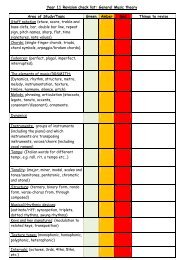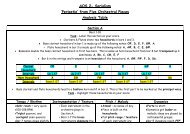Physics Unit 2 Revision (Higher tier)
Physics Unit 2 Revision (Higher tier)
Physics Unit 2 Revision (Higher tier)
Create successful ePaper yourself
Turn your PDF publications into a flip-book with our unique Google optimized e-Paper software.
<strong>Physics</strong> <strong>Unit</strong> 2 <strong>Revision</strong> (<strong>Higher</strong> <strong>tier</strong>)ForcesForced act in pairs. When 2 forces interact theyare equal and opposite in direction e.g. a personexerts a force on the chair but the chair applies anequal force upwards on the person, a reactionforce.Weight is also a force measured in newtons. Don’tconfuse mass and weight as mass is actually the amount of ‘stuff’ that makes upan object measured in kilograms. Weight is the force calculated byWeight (N) = Mass (kg) x Gravitational field strength (N/kg)WmgThe gravitational field strength on Earth is taken as 10N/kg.A resultant force is the sum of forces acting on an object.2N4NResultant force = 2N + 4N = 6N to the right2N4NResultant force = 4N - 2N = 2N to the rightBalanced forces occur when an object is stationary or moving at a constantspeed. The faster an object is moving the bigger the frictional forces acting onit.FResultant Force (N) = Mass (kg) x Acceleration (m/s 2 )ma
Sample Question 1
Sample Question 2
Distance-time and velocity-time graphsDistance-time graphs tell you how anobjects distance is changing over time.If there is a smooth slope on your graphthen the object is moving at a constantspeed. If there is a flat line then thereis no movement. A steeper slope meansa faster speed. If the slope isdownwards the object is returning tothe starting position. If there is anupwards curve (downward curve () on a distance time graph then the object is accelerating, a) means it is decelerating.In order to work out thespeed from the slope youchoose a section of theslope and determine whatsize it is relative to theaxis. Since speed isdistance ÷ time you thenuse those values from theslope. So in this caseSpeed = 4m ÷ 4s = 1m/sSpeed is how fast you are travelling and velocity is your speed in a givendirection.Distance (m)86420Distance-timegraph0 2 4 6 8 Time (s)Velocity-time graphs tell you how an objectsvelocity is changing over time. If there is asmooth slope on your graph then the objectis accelerating. If there is a flat line thenthe object is moving at a constant speed. Asteeper slope means a larger acceleration. IfVelocity (m/s)8642Velocity-timegraph00 2 4 6 8 Time (s)
there is a downwards slope then the object is decelerating. The area under thevelocity time graphs tells you the distance travelled. To work out theacceleration from a section of the slope you use the same method as above forthe distance-time graph.A velocity-time graph tells you how an objects velocity changes over a certaintime. This is the acceleration.Accelerati on ( m / s2Final) velocity( m / s) initialtime taken ( s)velocity( m / s)aV - UtSample Question 3
Sample Question 4
Cars and braking forcesHow quickly a car can come to a stop depends on the car and the driver. Thestopping distance is the thinking distance (which depends on the driversreactions) and the braking distance (which depends on the car and roadconditions).Stopping distance = thinking distance + braking distance
The thinking distance will be increased if the driver is tired, been drinkingalcohol, been on drugs etc. The braking distance will depend on the roadsurface, weather conditions and how well the car responds e.g. condition ofbrakes.Sample Question 5The Highway Code gives tables of the shortest stopping distances for cars travellingat various speeds. An extract from the Highway Code is given below.(a) A driver’s reaction time is 0.7 s.(i)Write down two factors which could increase a driver’s reaction time.1 ......................................................................................................................2 ......................................................................................................................(2)(ii)What effect does an increase in reaction time have on:A thinking distance; .....................................................................................B braking distance; ......................................................................................C total stopping distance? ..........................................................................(3)(b)Explain why the braking distance would change on a wet road................................................................................................................................................................................................................................................................................................................................................................................................................................................................................................................................................................................................................................................................................(2)
(c)A car was travelling at 30 m/s. The driver braked. The graph below is avelocity-time graph showing the velocity of the car during braking.Calculate:(i)the rate at which the velocity decreases (deceleration);....................................................................................................................................................................................................................................................Rate .......................... m/s²(2)(ii)the braking force, if the mass of the car is 900 kg;....................................................................................................................................................................................................................................................Braking force ............................... N(2)(iii)the braking distance.....................................................................................................................................................................................................................................................Braking distance .............................. m(2)(Total 13 marks)
Terminal velocityAn object falling through a fluid or gas will initially accelerate due to the forceof gravity. Eventually the force of gravity will be balanced by the up thrust ofthe liquid/gas; this makes the resultant force zero and the object will move atits terminal velocity (steady speed).The faster the object falls the greater the frictional force that acts.To the left isa velocitytime graphfor a skydiver whojumped outof a plane.Sample Question 6(a)The diagram shows a steel ball-bearing falling through a tube of oil.The forces, L and M, act on the ball-bearing.What causes force L?..................................................................................................................................................................(1)
(b)The distance – time graph represents the motion of the ball-bearingas it falls through the oil.(i)Explain, in terms of the forces, L and M, why the ball-bearingaccelerates at first but then falls at constant speed.......................................................................................................................................................................................................................................................................................................................................................................................................................................................................................................................................................................................................................................................................................................................................................(3)(ii)What name is given to the constant speed reached by the falling ballbearing?...........................................................................................................................(1)
Extension (m)(iii)Calculate the constant speed reached by the ball-bearing.Show clearly how you use the graph to work out your answer..................................................................................................................................................................................................................................................................................................................................................................................Hooke’s LawSpeed = ............................................................ m/s(2)(Total 7 marks)When a weight (force) is applied to a spring it extends. The amount it extendsis proportional to the force added. It is governed by the equation:Force (N) = spring constant (N/m) x extension (m)F(F = k x e )keThe spring constant can be determined from the gradient (slope of the line) ona force extension graph.Force extension graph for a spring765432100 2 4 6 8 10 12 14Force (N)Limit ofproportionalityChoose a section of the line and measure the amount of force and theextension. Then divide the force by the extension
For example: In the sample graph the section of the line chosen if for a forceof 6N and an extension of 3m. k = F ÷ ek = 6 ÷ 3 = 2 N/mAlso marked on the graph is the limit of proportionality. This is the point atwhich the spring can still return to its original length. Beyond this point thespring can never go back to its original length/shape.Sample Question 7(a)The pictures show four objects. Each object has had its shape changed.Which of the objects are storing elastic potential energy?................................................................................................................Explain the reason for your choice or choices.................................................................................................................................................................................................................................................................................................................................................................................................................................................................................................................................................................................................................................................................................................(3)
(b) A student makes a simple spring balance.To make a scale, the student uses a range ofweights. Each weight is put onto the spring andthe position of the pointer markedThe graph below shows howincreasing the weight made thepointer move further.(i) Which one of the followingis the unit of weight?.Draw a ring around your answer.joulenewtonkilogramwatt(1)(ii)What range of weights did the student use?......................................................................................................... (1)(iii)How far does the pointer move when 4 units of weight are on the spring?......................................................................................................... (1)(iv)The student ties a stone to the spring. The spring stretches 10 cm.What is the weight of the stone?......................................................................................................... (1)(Total 7 marks)
Force and energyWhen a force acts upon an object causing it to move a through a distanceenergy is transferred and work is done. The amount of work done is equal tothe amount of energy transferred. The amount of work done is calculated by:Work done (Joules, J) = Force applied (N) x distance moved (m)Box moved from A to B2NA5mBWork done = 2N x 5m = 10JIf you try to do work against a surface with friction then most of the energygets transformed into heat.Power is the amount of work done (energy transferred) every second and iscalculated using the following equationEPtWork can also be done on other objects. If you change the shape of an objectthen the energy gets stored in the object, e.g. an elastic band. This is elasticpotential energy. Remember, potential energy is stored energy that is ‘waiting’to be used, kinetic energy is movement energy.Gravitational potential energy is the amount of energy an object has when it isheld above the ground. It is calculated using the following equationGravitatio nalpotentialenergy ( J) mass(kg) gravitional field ( N / kg) height ( m)Example: A book of mass 0.5kg is on a shelf 2 metres off the ground. What isits gravitational potential energy if the gravitational field strength is 10N/kg.Answer: GPE = m x g x hGPE = 0.5 x 10 x 2 = 10J
To work out the kinetic energy a body has you need to know it’s mass and it’svelocity;Mass2000kgVelocity60m/sKinetic Energy = ½ x 2000kg x (50m/s) 2= ½ x 2000kg x 2500(m/s) 2= 2500000J OR 2500kJMomentumMomentum (has the symbol p) describes how much motion an object has. It ismeasured in kilogram metre per second (kg m/s). Like velocity, momentum hasmagnitude acting in a certain direction.Momentum (kg m/s) = Mass (kg) x Velocity (m/s)Mass = 0.1kgVelocity = 50m/sMomentum = 0.1kg x 50m/s= 5kg m/s
In all situations, momentum is conserved, providing there are no external forcesacting. For collisions, the momentum before the collision is equal to themomentum after the collision e.g. snooker ballsMomentum before collisionEQUALSMomentum after collisionp=mvp=0 p=0p=mvAnother example is cannon before being fired and after being fired. Before thecannon is fired the momentum is zero, after it is fired the cannon ball movesforward and the cannon moves back. The momentum of the cannon ball is thesame as the momentum of the cannon moving backwards.In this sort of example you should choose one direction to be positive and theother direction to be negative. The example below illustrates this point. I willchoose the right to be positive and the left to be negative.Before being firedAfter being fired-p cannon+p ballp = 0p ball - p cannon = 0
Sample Question 8
Sample Question 9
Static electricityIn static electricity when two objects are rubbed together the electrons movefrom one object to another. This causes one object to have an overall positivecharge and the other object to have an overall negative charge.Like charges repelUnlike charges attractNeutral objects are attracted to bothpositively and negatively charged objects.If you wanted to test if an object was charged then you could check if itattracted bits of paper, hair etc. It could attract or repel another chargedobject.If an object becomes highly charged then the potential difference betweenthen object and the ground increases and the objects will discharge. When acharged object discharges (goes to ground) then a spark might occur. This isthe electrons jumping from the object to the earthed conductor.
Sample Question 10A pupil did an experiment following the instructions below.1. Take a polythene rod (AB), holdit at its centre and rub both ends witha cloth.2. Suspend the rod, withouttouching the ends, from a stand usinga stirrup and nylon thread.3. Take a perspex rod (CD) andrub it with another cloth.4. Without touching the ends ofthe perspex rod bring each end of theperspex rod up to, but withouttouching, each end of the polythenerod.(a)When end C was brought near to end B they attracted each other.(i)Explain why they attracted each other...............................................................................................................................................................................................................................................(ii) What would happen if end C were brought near end A?.......................................................................................................................(3)(b)The experiment was repeated with two polythene rods.(i)Describe what you would expect the pupil to observe as the end ofone rod was brought near to the end of the other...............................................................................................................................................................................................................................................(ii)Explain your answer...............................................................................................................................................................................................................................................(2)
(c)Explain, in terms of electron movement, what happened as the rodswere rubbed with the cloths....................................................................................................................................................................................................................................................................................................................................................................................................................................................................................................................................................................................................................Current and circuitsWe use symbols in circuits and you need to be able to recognise and drawcircuits using the following symbols.(3)(Total 8 marks)OpenSwitchClosedSwitchLampCellDiodeThermistorBatteryVoltmeter(connect inparallel)Resistor Fuse VariableresistorAmmeter(connect inseries)Light dependent resistor (LDR)Light emitting diode (LED)A diode is a component thatonly allows current to flowone way in a circuitThis is a temperature resistor. Asthe temperature increases theresistance decreasesA LDR is a resistor whoseresistance decreases if thelight intensity increases(more light shining on it)This is a resistor whore resistancecan be changed. E.g. a dimmerswitchA light emitting diode (LED) is a component that only allows current to flowone way in a circuit and when the current is flowing that way it gives off light
Current (symbol I, measured in amperes, A) is the rate of flow of electricalcharges (symbol Q) or electrons i.e. The number of charges per second.Current is the amount of charges (measured in Coulombs) thatflow every second, it is represented by the equation:Charge, QCurrent (Ampere, A) = Charge (Coulombs, C) ÷ Time (s)Current, ITime, tSo if a circuit has a current of 2A that means that there are 2 coulombs ofcharge going around the circuit every secondQuick example: 6 Coulombs of charge go around a circuit every 2 seconds.What is the current?Answer: I = Q ÷ tI = 6C ÷ 2s = 3AVoltage or potential difference (symbol V, measured in volts, v) is theamount of energy transferred by the charges i.e. the amount of energy perchargeIf there is a 2V cell or battery in a circuitthen it gives 2 joules of energy to everycoulomb of charge. When these charges get tothe device in the circuit e.g. a bulb, then theenergy gets transferred to the device. Tocalculated potential difference/voltage you usethe following equation.Work done ( J)Potential difference ( V ) Charge ( C)Resistance (symbol R, measured in ohms, Ω) is something that apposes theflow of current.Voltage, current and resistance related bythe equation:V = I x RIVR
Current- potential difference graphs tell you how the current through acomponent varies with voltage.Resistor at a constant temperature A filament lamp A diodeThere are two types of circuits, parallel and series circuits.In a series circuit The total resistance is the sum of theresistance of each component in the circuito Total resistance (R total ) = R 1 + R 2 The current is the same at every point in thecircuit The voltage is shared between each componentin the circuitV totalV 2 V 1R 2 R 1o Total voltage (V total ) = V 1 + V 2In a parallel circuitV total The voltage is the same across each branchI totalo V total = V 1 = V 2 The total current through the circuit is the sum ofthe current through each componento Total current (I total )= I 1 + I 2I 1V 1I 2V 2
Sample Question 11Sample Question 12
Sample Question 13
Mains electricity and safetyIn circuits which are powered by cells/batteries the current only flows in onedirection, this is called direct current (d.c.).Alternating current (a.c.) is what we receive from power station and whatcomes out of plug sockets. This current changes direction i.e. the current moveback and forth in the circuit. The properties of the UK electrical supply are230 volts and the frequency is 50 cycles per second (50 Hertz [Hz]).If you were to look atD.C and A.C currenton an oscilloscope youcan see how thevoltage changes overtime.Direct currentAlternating currentFrom the oscilloscope trace you can determine the period and frequency of thealternating current (A.C.)PeriodThe period is the length of time for one completewave to pass. In the oscilloscope trace on the left,there are 5 scale divisions for the period. If onescale division is 0.005 seconds then the period is 5times that.Period = 0.005s x 5 = 0.02seconds
When you know the period you can calculate the frequency (the number ofcycles per second)Most of your electrical devices are connected tothe mains supply by a cable connected to a threepin plug. The electrical cable is composed of acopper wire surrounded by a plastic insulator.The three pin plug consists of 3 separate wirescalled the Earth wire, Live wire and Neutral wire.The live and neutral wires are responsible forcarrying the electrical supply to and from themains supply.The voltage of the live wire (red line) alternatesbetween positive and negative and the neutral wire(blue line) remains close to zero. The earth pin isused for safety (in particular with devices that havea metal case) in conjunction with the fuse. If thelive wire happens to come in contact with the metalcase then you could get an electrical shock as thecurrent will pass through you to get to the ground. However, the earth wire andfuse prevents this from happening. The earth wire will take the current fromthe live wire. This high current then flows through the fuse wire causing it tomelt.Fuses and circuit breakersFuses have different current ratings. The fuse will blow if the current exceedsthis rating e.g. a 3 amp fuse will blow if the current is equal to or greater than3 amps. Most common fuse ratings are 3A, 5A and 13A.
To know what rating of fuse to use you need to know the electrical power ofthe device. Electrical devices use different amounts of power (measured inwatts). Power is the amount of energy transformed by the device every second.The way to calculate power other than the one mentioned earlier is:Power ( W) current ( A) potential difference ( V)PIVIf an electrical fire has a power rating of 1150Wand the voltage used is 230V then what fuse shouldbe used?Rearranging the equation we get:I = P ÷ VI = 1150 ÷ 230 = 5AThe fuse that should be used is 13A because if a 3A or 5A fuse was used thenit would ‘blow’ even if the device was working correctly.Another safety device is a circuit breaker which is an electromagnet switchwhich opens (or ‘trips’) when there is a fault which stops the current flowing.The electromagnet is connected in series with the live wire and if the current istoo large this causes the magnetic field of the electromagnet to big enough topull the switch contacts apart. The switch will remain open until it is reset.These devices work quicker than fusesThere are also Residual Current Circuit Breaker (RCCB) which, like circuitbreakers, but work much faster than circuit breakers and fuses.Sample Question 14In the UK mains electricity is a 230 volt a.c. supply.(a)What is the frequency of the a.c. mains electricity in the UK?........................................................................................................................(1)(b) (i) What is an electric current?...............................................................................................................(1)
(ii) Explain the difference between an a.c. (alternating current) electricitysupply and a d.c. (direct current) electricity supply.............................................................................................................................................................................................................................................................................................................................................................................................................................................................(2)(c)A householder has a 10.8 kW electric shower installed in the bathroom.(i) Calculate the current drawn from the mains electricity supply by theshower.Write down the equation you use, and then show clearly how you work out youranswer.............................................................................................................................................................................................................................................................................................................................................................................................................................................................Current = .................................... A(2)(ii) The table gives the maximum current that can safely pass through electriccables of different cross-sectional area.Cross-sectionalareain mm 2Maximum safecurrentin amps1.0 11.52.5 20.04.0 27.06.0 34.010.0 46.016.0 62.0
The existing power sockets in the house are wired to the mains electricitysupply using 2.5 mm 2 cable.Use the data in the table to explain why the shower must not be connected tothe mains electricity supply using 2.5 mm 2 cable.............................................................................................................................................................................................................................................................................................................................................................................................................................................................(2)(iii) The circuit connecting the shower to the mains electricity supply mustinclude a residual current circuit breaker (RCCB) and not a fuse.Give two advantages of using a RCCB to protect a circuit rather than a fuse.1 ...........................................................................................................................................................................................................................2 ...........................................................................................................................................................................................................................(2)(Total 10 marks)Sample Question 15
Sample Question 16
Atoms and their propertiesIn the early 1900s the model of the atom was called theplum pudding model. It was believed that the atom was apositively charged fluid (the pudding) with electrons dottedinside it (the plums). This model was later disproved byRutherford and Marsden’s scattering experiment.The way they disproved this was by firing alpha particles (positively chargedparticles) at a gold leaf and observing that angles at which they got reflected.What they should have seen was the alpha particlespassing practically straight through. However, whatthey discovered was that a number of the particlesgot deflected at different angles; with some comingstraight back on themselves. What they concludedwas that most of the atom was empty space with asmall positively charged nucleus in the centre withelectrons orbiting the outside.Atoms contain protons, neutrons and electrons. The nucleusis made up of protons and neutrons. All atoms of aparticular element have the same number of protons e.g. allcarbons have the same number of protons; one carbon atomwon’t have more protons than another. Atoms of differentelements have different numbers of protons e.g. carbonsatoms have a different number of protons to an oxygen atom.The properties of the protons, neutrons and electrons are:Particle Relative mass Relative chargeProton 1 +1Neutron 1 0 (no charge)Electron Very small (0.0005) -1
Atoms normally have a no overall charge, due to have equal numbers ofelectrons and protons. However, atoms can gain or lose electrons and formcharged particles called ions. Some forms of radiation can create ions and thisradiation is called ionising radiation.Atoms have a mass number which tellsyou the number of protons and neutronsin an atom. They also have an atomicnumber which tells you the number of protons in the atom.In electrically neutral atoms, the number of protons must equal the number ofelectrons.Some atoms of the same element can have different mass numbersFor example: Carbon–12, Carbon–13, Carbon–14In these atoms the number of protons hasn’t changed, but the number ofneutrons has e.g. carbon–14 has 2 more neutrons than carbon–12. These arecalled isotopes.Isotopes which have an unstable nucleus (radio-isotopes) emit radiation ordecay. There are 3 forms of radiation they can give out, beta particle, alphaparticles and gamma rays.Alpha decay (4 2 ) is where an alpha particle (a positively charged particleconsisting of 2 neutrons and 2 protons i.e. a helium nucleus) is emitted from thenucleus of an atom. Alpha is the most ionising type of radiation.Tip for remembering: Alpha has the letter p in it so it is positively charged.Alpha also has the letter h in it so it is a helium nucleus.Beta decay (0 1 from the nucleus of an atom.) is when a beta particle (a fast moving electron) is emittedTip for remembering: beta has the letter e in it so it is an electron.
++++++++++++++Gamma decay (γ) is where a gamma ray (part of the electromagnetic spectrum)is emitted from the atom. Gamma rays have no charge and no mass. Gamma isthe least ionising form of radiationTip for remembering: Gamma has 2 m’s beside each other which looks like awave (mm - ).There are different sources that can give outradiation and radiation has been measured by geigercounters even when there was no known source ofradiation around. This called background radiationand some sources are natural and others are man made.We can tell what radiation is emitted depending on howit gets deflected in a magnetic and electric field.BetaGammaAlpha- - - - - - - - - - - - - --As a beta particle has a negative charge it will be repelled by the negativelycharged plate and attracted to the positively charged plate. As a gamma ray ispart of the electromagnetic spectrum and has no charge it will pass straightthrough. As an alpha particle has a positive charge it will be repelled by thepositively charged plate and attracted to the negatively charged plate.The different types ofradiation emitted fromisotopes can be stopped bydifferent substances. Itdepends on how penetratingthe radiation is. Alphaparticles can be stopped by
Counts per minuteyour skin, paper or even a few centimetres of air. Beta is more penetrating andis stopped by a few centimetres of aluminium. Gamma is the most penetratingas is stopped by lead.Alpha can be the most dangerous to humans as it is more likely to be absorbedby the cells. Beta and gamma are more likely to pass through your cells.In order to measure how much radiation is given off by a substance we use aGeiger counter. A Geiger counter measures the count rate which is the amountof radiation emitted. The higher the count rate the more radiation is given off.An example of alpha and beta decayRadioactive decay is a random process but there is a pattern to it. Thispattern is called the halflife.Half-life is the amountof time it takes for theradiation count rate to fall byhalf. So for the graph to theleft the count rate starts at80. The count rate will be2 dayshalf when it reaches 40. Thetime taken for it to reach 40is 2 days. Therefore 2 days isthe half life. After another 2Time (days)
days the radiation will fallen by half again and reached 20 counts perminute.If we have a substance which has a mass of 50g and a half life of 2 days howwould the mass of the substance change?After 2 days the mass would be 25g (half of 50g). 25 g has radiated away.After 4 days the mass would be 12.5g (half of 25g). 37.5g has radiated away.After 6 days the mass would be 6.25g (half of 12.5g). 43.75g has radiated awayand so onUses of radioactive decayPeople who work with radioactive sourceoften were special badges. These badgeshave a special photographic film in themwhich turns darker the bigger theexposure. Radioactive sources can beused as tracers. They can be added toplant fertiliser and you can then check ifthe plant has taken up the fertiliser. It isalso used in the medical industry butdoctors must ensure that it has a short half life so that it doesn’t stay in thebody very long and cause damage.Alpha sources are used in smokedetectors. The alpha particleshelp to create an electriccurrent in the smoke detector byionising the air. When smokeparticles enter the smokedetector the electric currentdrops, this causes the alarm togo off.
Beta particles are often used to measure the thickness of materials. A Geigercounter measures the amount ofradiation passing through thematerial. If the radiation is toohigh then the sheet is too thin.If the radiation is too low thenthe material is too thick.Nuclear fission and fusionFusion is the easiest to remember as it is exactly like it sounds. Fusion is wheretwo atomic nuclei join together to form a larger one. When this occurs energyis released. It is by this process that stars get their energy. For example, twohydrogen atoms can fuse together (and release energy) to create helium.Fission is the opposite; it is the splitting of an atomic nucleus and it is theprocess that nuclear power plants use. The two most common fissionablematerials are uranium 235 and plutonium 239.In order for fission to occur the atomicnucleus must absorb a neutron. The neutronis fired at the nucleus and caused thenucleus to spilt, forming two smaller nuclei.When the splitting occurs energy isreleased along with 2 or 3 more neutrons.These neutrons are then absorbed by othernuclei causing the process to repeat. This iscalled a chain reaction. This reaction iscontrolled in a nuclear reactor by usingcontrol rods. This rods absorb neutrons ifthe reaction needs to be slowed down.
Sample question 17
Sample question 18
Sample Question 19
Sample Question 20
Life cycle of starsPlanets form when lumps of rock get attracted to each other due to gravity.Stars form when clouds of gas and dust from space gets pulled together due tothe gravitational attraction. The amount of gas build up (gets moreconcentrated and forms a protostar. When the protostar gets denser andhotter nuclear reactions (i.e. fusion) start which causes hydrogen and otherlighter element to fuse together. During fusion energy gets released which iswhat makes stars hot.Protostars then become main sequence stars when the forces within the starare balanced (gravitational force and expansion/outward force). Our sun is amain sequence star. After the main sequence star their life cycle can take 2possible routes depending on their mass.When the big bang occurred 13 billion years ago the only element in existencewas hydrogen. However, due to nuclear fusion in stars all the other elementswere created and when stars explode (go supernova) all of those elements arereleased into the universe. This means that the elements that make up yourbody, the oxygen that you breathe right now were formed inside stars.
Sample Question 21(a)Choose the best words from the box to complete the following sentences.billions fission friction fusion gasesgravity liquids millions thousands(i)(ii)Stars form when enough dust and ............................................................. fromspace are pulled together by .................................................................(2)Stars are able to give out energy for millions of years by the process of........................................................................................................................... (1)(iii) The Sun is one of many ........................................... of stars in our galaxy. (1)(b)What is the name of our galaxy?...............................................................................................................................Sample Question 22Read this statement from a website.Immediately after the ‘big bang’, at the start of the Universe, there wereonly atoms of the element hydrogen (H).Now the Universe contains atoms of over one hundred elements.(1)(Total 5 marks)(a)Explain how atoms of the element helium (He) are formed in a star.............................................................................................................................................................................................................................................................................................................................................................................................................................................................................................................................(2)(b) Explain how atoms of very heavy elements, such as gold (Au), wereformed..............................................................................................................................................................................................................................................................................................................................................................................................(2)
(c) Explain how, and when, atoms of different elements may be distributedthroughout the Universe.............................................................................................................................................................................................................................................................................................................................................................................................................................................................................................................................Sample Question 23Stars do not stay the same forever.(2)(Total 6 marks)(a)Over billions of years the amount of hydrogen in a star decreases. Why?....................................................................................................................................................................................................................................................................... (1)(b) Describe how a massive star (at least five times bigger than the Sun) willchange at the end of the main stable period. To gain full marks in this question youshould write your ideas in good English. Put them into a sensible order and use thecorrect scientific words.........................................................................................................................................................................................................................................................................................................................................................................................................................................................................................................................................................................................................................................................................................................................................................................................................................................................................................................................................................................................................................................................................................................(4)(c)(i)The inner planets of the solar system contain atoms of the heaviest elements.Where did these atoms come from?......................................................................................................................................................................................................................................................(1)
(ii) What does this tell us about the age of the solar system compared with manyof the stars in the Universe?...........................................................................................................................How science works(1)(Total 7 marks)When carrying out experiments and answering questions based on interpretingexperiment you need to know the following.The independent variable is what is changed during an experimentRemembering Tip: Independent starts with I so it is the variable that I changeThe dependent variable is what you measure in the experiment i.e. the resultsThe control variables are the things you want to keep the same during anexperiment.During experiments we repeat measurements to make the results more reliable.When plotting a graph for your results you generallyplot the dependent variable along the y-axis and theindependent variable along the x-axis.DependentvariableYour independent/dependent variable can either be continuous or categoric.Continuous variables are numbers 1.2, 5.76, 3.0 etc – draw a line graphCategoric variables are categories e.g. colours, metals – draw a bar chartIndependentvariableDescribing results This graph is showing a positive correlation, i.e. as onevariable increases so does the other and the line goes up. A negative correlation is when one variable goes up theother goes down, the line would go downwards.Experimental procedurePrediction: What you think will happenPlan: How you are going to carry out your experimentConclusion: What you have found out from the experimentFair test: When you make sure each experiment is set up the same way
SOLUTIONS TO EXAM QUESTIONQuestion 1Question 2
Question 3Question 4Question 5(a) (i) tiredness / boredomdrugsalcoholdistractionany two for 1 mark each2(ii)A greater / longerB no effectC greater / longereach for 1 mark 3(b)on a wet road: there is less friction / gripfor 1 markbraking distance is greater / takes longer to stop or car skids / slides forwardfor 1 mark
(c) (i) deceleration = gradient or 30 / 4.8each for 1 mark(ii) force = mass × acceleration or 900 × 6.25each for 1 mark22(iii)distance = area under graph or0.5 × 4.8 × 30 or average speed × time or 15 × 4.8Question 6Accept answer in terms of change in k.e. = work doneif incorrect unit given (eg 72km) then no markeach for 1 mark2[13](a) gravity accept weightdo not accept massaccept gravitational pull 1(b) (i) Initially force L greater than force Maccept there is a resultant force downwards(as speed increases) force M increasesaccept the resultant force decreaseswhen M = L, (speed is constant)accept resultant force is 0accept gravity/weighty for Laccept drag/ upthrust/resistance/friction for Mdo not accept air resistance for M but penalise onlyonce111(ii) terminal velocity 1(iii) 0.15accept an answer between 0.14 – 0.16an answer of 0.1 gains no creditallow 1 mark for showing correct use of the graph2 [7]
Question 7(a)B or bungee cordsC or springs or playground ridewill go back to original shape/size111(b) (i) newton(ii) 0 – 5 (N) or 5accept1 – 5 (N)do not accept 411(iii)16 (cm)1(iv)Question 82.5 (N)accept answer between 2.4 and 2.6 inclusive1[7]
Question 9Question 10(a) (i) Ends have chargeWhich is opposite on each rod2(ii)Attracts1(b) (i) Repulsion1(ii)Ends have same charge1(c)Electrons move between cloth and rodWhere material that gains electrons becomes negativeWhere material that loses electrons becomes positive3[8]
Question 11Question 12
Question 13Question 14(a)50 hertz1(b) (i) a flow of charge / electrons1(ii)a.c. is constantly changing direction1whilst d.c. always flows in the same direction1(c) (i) 46.9accept 47.0allow 1 mark for correct transformation and substitutionie2(ii) current (46.9 A) exceeds maximum safe current for2.5 mm 2 cableaccept cable needs to be 16.0 mm 2 1therefore if a 2.5 mm 2 cable were used it would overheat / meltcable needs to be 10.0 mm 2 limits maximum credit to 1 mark1(iii)can be reset1disconnects circuit faster (than a fuse)1[10]
Question 15
Question 16
Question 17Question 18
Question 19
Question 20
Question 21(a) (i) gases (1)gravity (1)correct order essential for credit 2(ii) fusion 1(iii) billions 1(b) Milky Way 1[5]Question 22(a) fusion (1)of hydrogen/H (atoms)(1)do not credit any response which looks like ‘fission’ or the ‘word’ ‘fussion’credit only if a nuclear reaction2(b) fusion of other/lighter atoms/elements (1)reference to big bang nullifies both marksduring super nova/explosion of star(s) (1)2
(c) explosion of star(s)/super nova (1)reference to big bang nullifies both marks reference to the star running out ofenergy/material nullifies both marksat the end of the ‘life’ of star(s) / when they ‘die’ (1)Question 23(a) converted into heliumaccept helium createdaccept converted into heavier elementsaccept used up in nuclear fusion / to produce energydo not accept any reference to burning(b) turns / expands into a red giantcontradictions negate markcontracts and explodes or becomes a supernova2[6]111may form a (dense) neutron star or (if enough mass shrinks to) form a blackholeaccept forms a neutron star and (then) a black holeQuality of written communicationcorrect points must be in sequence(c) (i) supernova or remains of an earlier starignore super nebula111(ii)younger or not formed at the time of the Big Bang1[7]
















